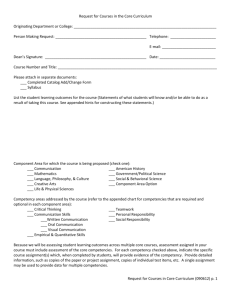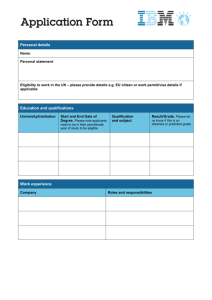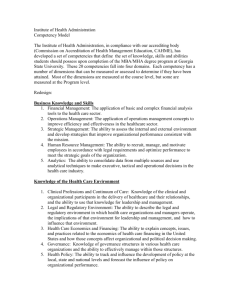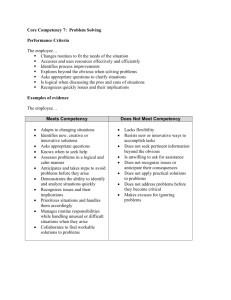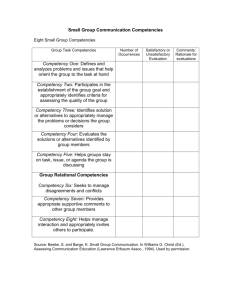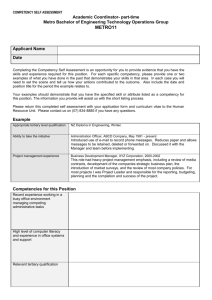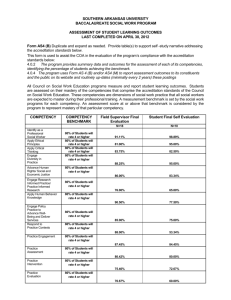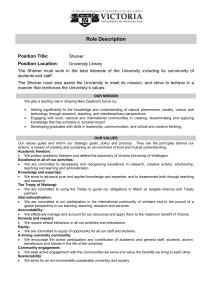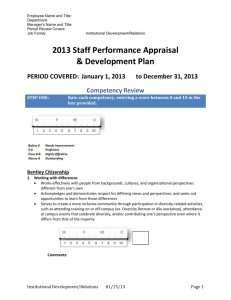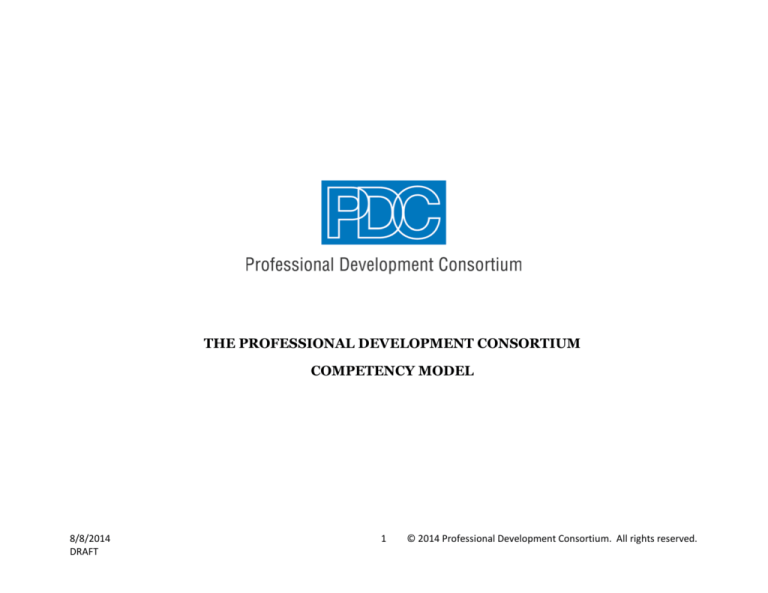
THE PROFESSIONAL DEVELOPMENT CONSORTIUM
COMPETENCY MODEL
8/8/2014
DRAFT
1
© 2014 Professional Development Consortium. All rights reserved.
8/8/2014
DRAFT
2
© 2014 Professional Development Consortium. All rights reserved.
Table of Contents
Message from the Chair: ..............................................................................................................................................................................................4
Introduction .................................................................................................................................................................................................................5
Methodology ...............................................................................................................................................................................................................6
Acknowledgements .....................................................................................................................................................................................................7
Model Key ....................................................................................................................................................................................................................8
Characteristics of PD Professional Career Levels .........................................................................................................................................................9
Competency: Professionalism ...................................................................................................................................................................................11
Performance Statements .......................................................................................................................................................................................13
Competency: Leadership, Management and Organizational Development ..............................................................................................................17
Performance Statements .......................................................................................................................................................................................18
Competency: Legal Industry Knowledge and Functional Expertise ...........................................................................................................................23
Performance Statements .......................................................................................................................................................................................25
Competency: Performance Management and Professional Development ................................................................................................................29
Performance Statements .......................................................................................................................................................................................31
References: ................................................................................................................................................................................................................34
8/8/2014
DRAFT
3
© 2014 Professional Development Consortium. All rights reserved.
Message from the Chair:
In 2015, the Professional Development Consortium (PDC) will celebrate its 25th anniversary as the leading organization
dedicated to the professional development of attorneys. From its beginnings to the present, PDC members have been the
thought leaders and “doers” on all fronts relating to attorney professional development, including the creation of benchmarks
and competencies for attorneys. As our roles as Legal Professional Development leaders have expanded over these 25 years,
it’s only fitting that we create a Competency Model for ourselves, which is provided here. As you will see, the model is
comprehensive, covering the diverse areas that now fall within legal professional development. I’m proud of the PDC for
producing this model, which will help guide the development and growth of our profession going forward.
I offer sincere thanks to my colleague Kathleen Dunn, who shepherded this large effort, and to the dedicated members of the
Competency Project Committee.
Director of Attorney Training & Development
Pillsbury Winthrop Shaw Pittman LLP
8/8/2014
DRAFT
4
© 2014 Professional Development Consortium. All rights reserved.
Introduction
The PDC is pleased to present the first competency model developed specifically for Legal Professional Development
practitioners. Through professional development and continuous improvement, Legal PD practitioners can contribute
significantly to their organization’s success.
This competency model is designed to serve as a resource for Legal PD professionals interested in developing
proficiency within each competency, from professionals just beginning their Legal PD careers to those at the executive level.
This model is intended to be used for developmental purposes only and should not be used for selection purposes.
Competencies are individual characteristics such as knowledge, skills, abilities, self-image, traits, mindsets, feelings and
ways of thinking that, when used in the appropriate roles, achieve a desired result.
Based on both the Society for Human Resource Management (SHRM) competency standards and best practices
identified by SHRM and the Association for Talent Development (ATD), the PDC Competency model includes four core
competency areas and eight sub-competencies. The core competencies are Professionalism; Leadership, Management and
Organizational Development; Legal Industry Knowledge and Functional Expertise; and Performance Management and
Professional Development. For each primary competency, we provide an overarching definition, associated subcompetencies,
behaviors demonstrated by individuals who are the most proficient at that competency, and behavioral standards that
characterize successful Legal PD professionals at the relevant career stage.
Success as a legal PD professional does not depend on mastering all core competencies by all practitioners: We
recognize that any organization’s strength results in part from diversity of talents. Nor should core competencies be
considered a checklist. “Checking a box” does not ensure success. Instead, core competencies can provide “guideposts along
the road of development” for individuals in legal professional development.
The PDC Competency model can be a powerful organizational tool that puts practitioners on a clear path to growth and
development. It will undergird important organizational functions such as recruitment, hiring and retention, training and
development, and performance management.
8/8/2014
DRAFT
5
© 2014 Professional Development Consortium. All rights reserved.
Methodology
Phase 1: Review of the literature. Recent publications in the Legal PD field were reviewed as well as any archived
materials. The review process was extended to include feedback and reports from PDC meetings and conferences. This
activity produced the big-picture conclusions about the direction of the Legal PD profession. An initial discussion with the
membership identified what knowledge, skills, abilities, and behaviors are currently possessed and will be needed in the
future.
Phase 2: Data collection. This phase involved collecting detailed day-to-day job data from Legal PD professionals
through a series of surveys developed and administered by the Competency Project Committee. Leaders in the field were
interviewed and questioned about global trends and current and future needs of the profession. Additionally, “in-thetrenches” professionals were interviewed to develop a more accurate picture of the specific behaviors that contribute to
successful job performance. We also used social media and discussion boards to solicit targeted feedback. This enabled a
robust discussion from a wider cross-section of the senior practitioners.
Phase 3: Validation. A survey was developed using all the information learned in Phases 1 and 2. This comprehensive
survey was administered to the entire membership base. Similar in design to the occupational survey (Phase 2), the validation
survey asked for judgments about the relative importance of the competencies, areas of expertise, and key knowledge and
actions along with their component behaviors. Consistent results with Phases 1 & 2validated our findings. This methodology
ensured that the content had broad applicability.
8/8/2014
DRAFT
6
© 2014 Professional Development Consortium. All rights reserved.
Acknowledgements
This project is the culmination of many hours of work by dedicated members of the PDC. All volunteers, the PDC
professionals who contributed their time, expertise, and experience to developing the PDC Competency model are to be
recognized and congratulated.
Special thanks to Cindy Weinberg for pulling the materials all together and for proofreading and to Ross Guberman,
PDC Trusted Advisor for editing!
Director, Learning & Professional Development
Squire Patton Boggs
Lisa Devlin, Nixon Peabody LLP
Jennifer Foster, Debevoise & Plimpton LLP
Elizabeth Foster-Nolan, Goulston & Storrs
Rebecca Killion, McKenna Long & Aldridge LLP
Emily Leeson, Alston & Bird LLP
Terri Mottershead, Principal, Mottershead Consulting*
Gillian Murray, Bryan Cave
Jeanne Picht, Lawyer Metrics*
Roslyn Pitts, K&L Gates LLP
Cindy Weinberg, Squire Patton Boggs
In alphabetical order:
Maria Arlotto, Ropes & Gray LLP
Michael Beltran, Dechert LLP
Andy Colón, Dickstein Shapiro LLP
Andrea Conley, Thompson Coburn LLP
Tammy Cowser, Marshall, Gerstein & Borun LLP
Nadine Dallitis, Covington & Burling LLP
Rachel Dawson, Faegre Baker Daniels
8/8/2014
DRAFT
7
*Alumna
© 2014 Professional Development Consortium. All rights reserved.
Model Key
Each competency consists of five distinct elements: title, definition, sub-competencies, behaviors, and performance
statements. These elements are explained in the key below.
TITLE
DEFINITION
SUB
COMPETENCIES
BEHAVIORS
PERFORMANCE
STATEMENTS
8/8/2014
DRAFT
KEY
This is the title of the competency.
This is the overall definition of the competency.
These are more specific competencies related to the relevant general competency.
These are behaviors demonstrated by individuals who are the most proficient at the
indicated competency.
These are statements for performance at the four career stages. Each performance
statement represents a behavioral standard that characterizes a successful PDC
professional at the relevant level.
8
© 2014 Professional Development Consortium. All rights reserved.
Characteristics of PD Professional Career Levels
LEVEL 1:
An “Early Level” PD professional characterized as follows:
• Is a specialist in a specific support function or is a generalist with limited experience
• Holds a formal title including, but not limited to, assistant, coordinator, junior role, or clerk
Example: Jamie is relatively new to the PD profession and has just over a year of experience as a PD professional. Jamie is a
specialist who supports a specific function in the PD department. Some of her responsibilities include supporting PD
initiatives, executing tasks passed down from management, and operating at the tactical and transactional levels.
LEVEL 2:
A “Mid-Level” PD professional characterized as follows:
• Is a generalist or a senior specialist
• Manages projects or programs
• Holds a formal title including, but not limited to, PD manager, generalist, or senior specialist
Example: Tyler has about five years of experience as a PD professional. While Tyler is a PD generalist, he has colleagues with
similar levels of experience and responsibility who are senior PD specialists. Some of his responsibilities include managing
projects, programs, and initiatives, implementing plans passed down, and delegating tasks to early level staff.
LEVEL 3:
A “Senior Level” PD professional characterized as follows:
• Is a very experienced generalist or specialist
• Holds a formal title including, but not limited to, senior manager, director, or principal
Example: Adison is a seasoned PD professional with about ten years of experience. While Adison is a very experienced
specialist, Adison has colleagues with similar levels of experience and responsibility who are very experienced generalists.
8/8/2014
DRAFT
9
© 2014 Professional Development Consortium. All rights reserved.
Some of his responsibilities include developing and leading implementation plans and analyzing business information.
LEVEL 4:
An “Executive Level” PD professional characterized as follows:
• Is typically one of the most senior leaders in PD
• Holds the top PD job in the organization or functions as a VP
Example: With 15 years of experience, Helen is the organization’s most senior PD professional. As a member of the
organization’s executive committee, Helen serves as an organizational leader and as a designer of learning strategy.
8/8/2014
DRAFT
10
© 2014 Professional Development Consortium. All rights reserved.
Competency: Professionalism
Behaviors
Definition:
•
Professionalism is the skill, good judgment, and polite
behavior that is expected from a person who is trained to do
a job well OR the level of excellence or competence that is
expected of a professional.
•
•
Sub competencies:
•
•
•
•
Written Communication
Oral Communication
Interpersonal Skills
o Teamwork, cooperation, delegation
o Tact and diplomacy
o Building and managing relationships
o Building collaborative relationships
o Adaptability/flexibility
o Resiliency
Ethics/Integrity
8/8/2014
DRAFT
•
•
•
•
•
11
Effectively convey ideas and information in writing
using language that is appropriate to both the topic’s
complexity and the reader’s knowledge and
understanding
Effectively express ideas and information through
non-verbal communication and the spoken word
Encourage colleagues to be excited, enthused, and
committed to furthering the organization’s
objectives
Promote cooperation and commitment within a
team to achieve goals and deliverables
Help remove barriers to team productivity and
success
Ensure joint ownership of goal setting,
commitments, and accomplishments
Respond to difficult, stressful, or sensitive
interpersonal situations in ways that minimize
potential conflict
Maintain good working relationships with internal
and external clients
© 2014 Professional Development Consortium. All rights reserved.
•
•
•
•
•
•
•
•
•
•
•
•
8/8/2014
DRAFT
12
Build constructive working relationships
characterized by a high level of acceptance,
cooperation, and mutual regard
Develop, maintain, and strengthen partnerships
with others inside or outside the organization who
can provide information, assistance, and support
Maintain effectiveness when experiencing major
changes in work tasks, the work environment, or
conditions affecting the organization
Remain open to new people, thoughts, and
approaches
Adapt to structures, processes, requirements, or
cultures
Bounce back, or even grow, in the face of pressures
and threats
Withstand adverse events and stressful situations
without falling apart
Earn the trust, respect, and confidence of coworkers
and clients through honesty, forthrightness, and
professionalism in all interactions
Respect and maintain confidentiality
Keep promises and commitments made to others
Avoid situations and actions that are inappropriate
or that present a conflict of interest
Adhere to a set of core values that are represented
in decisions and actions
© 2014 Professional Development Consortium. All rights reserved.
Performance Statements
Level 1
•
•
•
•
•
•
•
•
•
•
•
•
•
•
•
•
•
•
8/8/2014
DRAFT
Prepares thoughtful, high quality written communications, including correspondence that
exhibits careful preparation, organization, and attention to detail, for review by supervisor.
Consistently follows standard rules of language for spelling, punctuation, grammar, word
usage, sentence structure, and composition.
Proofreads accurately with close attention to detail.
Expresses views, advice, and positions effectively and appropriately on straightforward
matters both within and outside the firm or organization.
Actively listens to other people in the conversation. Accurately summarizes what others
have said.
Ensures that the practical needs of the team are met and obtains needed resources and
information.
Helps new team members get up to speed.
Listens patiently to others experiencing conflict.
Treats all team members with fairness and respect.
Timely notifies others of changes or problems.
Displays a positive, optimistic attitude toward the work to be done, coworkers, customers,
management, and employer policies.
Interacts in a respectful manner that maintains the dignity of all.
Demonstrates a high level of dedication and commitment.
Demonstrates honesty, truthfulness, and fairness when dealing with co-workers and
clients.
Respects other people’s rights, values, diversity, time, privacy, and property.
Recognizes inappropriate situations and actions that challenge ethical standards.
Demonstrates discretion when handling confidential matters.
Demonstrates dependability, keeps promises and commitments, and exercises good
judgment.
13
© 2014 Professional Development Consortium. All rights reserved.
Level 2
•
•
•
•
•
•
•
•
•
•
•
•
•
•
•
Level 3
•
•
•
•
•
•
•
8/8/2014
DRAFT
Demonstrates Level 1 competencies.
Drafts documents that are clear and concise and that require few modifications.
Chooses the most effective and meaningful written form to express ideas and information.
Recognizes when charts, graphs, or other visual aids help communicate information.
Effectively and appropriately advocates positions orally on complex matters.
Explains or presents information in a clear, concise, logical manner that promotes
understanding of the intended message.
Acknowledges other people’s feelings, concerns, opinions, and ideas.
Acknowledges other people’s skills, experience, creativity, and contributions.
Disagrees tactfully.
Expands on others’ ideas.
Organizes people and resources to effectively and efficiently attain predetermined
objectives.
Works through difficult or awkward interpersonal situations in a positive manner.
Recognizes when other people need assistance and offers to help.
Develops the trust, confidence, and respect of co-workers, clients, and others in all
interactions.
Responds appropriately to inappropriate situations and actions that challenge ethical
standards.
Models the highest professional ethics and standards.
Demonstrates Level 2 competencies
Takes primary responsibility for correspondence, with minimal review by supervisor.
Composes clear, direct, and succinct written messages that effectively convey ideas or
information to the intended reader. Recognizes when language requires adjustment to
achieve understanding by different readers, and readily rewords messages accordingly.
Distills the most important and pertinent points in a document to promote ready
understanding of the material’s essence.
Collaborates on larger written projects with colleagues.
Effectively and appropriately advocates positions orally on complex and sensitive matters
both within and outside the firm or organization.
Demonstrates effective oral presentation skills for discrete topics and issues.
14
© 2014 Professional Development Consortium. All rights reserved.
•
•
•
•
•
•
•
•
•
•
•
•
•
•
•
8/8/2014
DRAFT
Advocates capably on behalf of the organization’s position and clients both internally and
externally.
Assesses the audience’s needs and adjusts language, tone, pace, and volume, to ensure
audience understanding.
Ensures that all pertinent information is included in the spoken message and emphasizes
the most important points to promote the ready understanding of the material’s essence.
Creates an environment that promotes sharing of diverse perspectives and differing
viewpoints.
Recognizes and celebrates workplace success and achievement.
Defines problems in a non-threatening manner.
Gives and seeks input from others when formulating plans or recommendations; gains the
support of others through persuasiveness, credibility, and expertise.
Acts as a performance coach by providing tools and giving practical support to others when
learning how to approach a task or problem, and communicates the underlying rationale so
that others can think through future issues on their own.
Shares negative feedback in behavioral rather than personal terms.
Leads by example and sets clear, reasonable expectations and standards for professional
behavior.
Influences others to approach issues positively (for example, sees issues as “challenges or
opportunities” rather than “problems”).
Addresses problems and issues in an open, constructive, and professional manner.
Exhibits sound judgment when responding to inappropriate situations and actions that
challenge ethical standards or that create the appearance of a conflict of interest.
Holds self and others accountable for meeting articulated commitments and ethical
standards.
Does not misrepresent self or use position for personal gain.
15
© 2014 Professional Development Consortium. All rights reserved.
Level 4
•
•
•
•
•
•
•
•
•
•
•
•
•
•
•
•
•
•
•
8/8/2014
DRAFT
Demonstrates Level 3 competencies.
Takes supervisory responsibility for reviewing and editing other people’s written work
product.
Organizes the flow of information in a document or report so that facts or ideas build upon
one another logically to lead the reader to the desired conclusion.
Effectively translates complex or technical concepts into messages that laypeople can
readily understand and grasp.
Connects effectively with a wide range of audiences.
Demonstrates effective oral presentation skills for complex and sensitive topics and issues.
Effectively translates complex or technical concepts into messages that laypeople can
readily understand and grasp.
Instills confidence in ability to persuasively and effectively represent the client’s interest.
Speaks in a way that captures and holds the listener’s attention. Favors language likely to
persuade or influence the listener’s opinions.
Thinks beyond current responsibilities and invests in the firm organization by actively
participating as a leader in initiatives or management activities.
Empowers others to take appropriate action
Helps people solve problems and accomplish goals.
Inspires others to follow example and direction voluntarily.
Facilitates development of shared mission, vision, and key values and uses those principles
to guide actions.
Resolves conflict and disagreements constructively.
Models appropriate stewardship of funds and resources.
Inspires trust, confidence, and respect in colleagues, co-workers, clients, and others in all
interactions.
Models integrity and professionalism.
Effectively addresses inappropriate situations and actions that challenge ethical standards
or that create the appearance of a conflict of interest.
16
© 2014 Professional Development Consortium. All rights reserved.
Competency: Leadership, Management and Organizational Development
Behaviors:
Definition: promotes organizational mission and goals and
shows the way to achieve them; creates a positive work
environment; links mission, vision, values, goals, and
strategies to everyday work; sees the potential in others and
takes opportunities to apply and develop that potential; sets
clear, meaningful, challenging, and attainable group goals
and expectations that are aligned with those of the
organization. Increases organizational effectiveness and
facilitates personal and organization change through
interventions driven by social and behavioral science
knowledge.
•
•
•
•
•
•
•
•
•
•
Sub competencies:
•
•
•
•
•
•
•
•
Align talent management with organizational objectives
Manage change
Department Management
Staff Management
Diagnosis
Planning
Intervention
Evaluation
8/8/2014
DRAFT
•
•
•
•
•
17
Establish a vision
Establish strategies
Manage staff in ways that improve their ability to
succeed
Align the right work with the right people
Provide staff with coaching, training and
opportunities for growth and development
Give ongoing, constructive feedback on job
Implement action plans
Develop and monitor budgets
Manage external resources
Manage own time, priorities, and resources to
achieve goals
Develop or enhance organization’s mission
statement or vision statement
Help align functions in an organization so that they
are working together for a common purpose
Identify and facilitate a long-range strategy for
managing change
Help develop policies and procedures to improve
the ongoing operation of the organization
Implement process to improve the ongoing
operations of the organization
© 2014 Professional Development Consortium. All rights reserved.
Performance Statements
Level 1
•
•
•
•
•
•
•
•
•
•
•
•
•
Level 2
•
•
•
•
•
•
8/8/2014
DRAFT
Ensures that the practical needs of the team are met by obtaining needed resources,
information, and personnel,.
Understands the experience and capabilities of team members and works to fill gaps (for
example, by getting the right people).
Treats all team members with fairness and respect.
Helps new team members get up to speed.
Structures and directs work on projects or programs.
Gathers facts and analyzes data using systematic methods such as surveys and focus
groups.
Develops knowledge in the use of data, evidence-based research, benchmarks, and
business metrics to facilitate decision making.
Reports on data entry and key metrics.
Develops a basic working knowledge of statistics, research methods, measurement
concepts, and metrics.
Identifies sources of data and information and learns where to find the most relevant
information for solving problems.
Conducts data entry and tracking of statistics and metrics.
Collects and synthesizes data through surveys, focus groups, research, and other methods.
Engages in preliminary analysis of collected data and reports findings to senior staff.
Demonstrates Level 1 competencies.
Implements effective measures for enhancing team morale and productivity.
Sets high standards for the team.
Helps people and resources effectively and efficiently pursue predetermined objectives.
Creates an environment that promotes sharing of diverse perspectives and differing
viewpoints.
Communicates team achievements and supports individuals’ career objectives.
18
© 2014 Professional Development Consortium. All rights reserved.
•
•
•
•
•
•
•
•
•
•
•
•
Level 3
•
•
•
•
•
•
•
•
•
•
•
•
8/8/2014
DRAFT
Maintains working knowledge of measurement concepts, data collection, and analysis.
Maintains working knowledge of statistics and metrics.
Asks critical questions to help prepare and interpret data studies and metrics.
Stays focused on purpose of intervention.
Involves participants in process.
Synthesizes data gathered into themes.
Delineates best practices that will work for firm’s business unit.
Identifies patterns in data and raises relevant issues to higher-level management.
Ensures quality work product.
Executes case and pilot studies to address specific problems and questions.
Analyzes data and reports findings and trends.
Suspends judgment; maintains objectivity.
Demonstrates Level 2 competencies.
Serves as a resource for younger associates seeking advice about practice area skills,
research and legal analysis, and professional development.
Acts as a performance coach by providing tools and giving practical support to others when
learning how to approach a task or problem and communicates the underlying rationale so
that others can think through future issues on their own.
Channels ambition into the firm.
Displays ingenuity in meeting challenges.
Provides leadership and guidance to enhance other people’s professional development and
to encourage their success.
Seeks out opportunities to mentor junior associates.
Defines the project’s or program’s goals and defines criteria for success. Clarifies the
related roles and responsibilities, deliverables, milestones, limits for independent decisionmaking.
Ensures that staff has access to the resources they need.
Ensures that staff have the skills they need.
Develops reasonable performance standards.
Integrates the ideas and needs of others when developing feasible strategies to achieve
goals. Obtains stakeholder support for those strategies.
19
© 2014 Professional Development Consortium. All rights reserved.
•
•
•
•
•
•
•
•
•
•
8/8/2014
DRAFT
Evaluates progress and success against performance standards. Appraises and resolves
deficiencies and challenges. Ensures that deadlines are met and keeps stakeholders
informed of project or program status.
Help develop knowledge management and change management vision and strategy.
Examines data to assist in developing effective and innovative knowledge management
and change management strategies.
Encourages collaboration by examining the organization’s design and culture.
Facilitates culture of acceptance of knowledge management and change management;
supports innovation; helps break down barriers between business units, functions,
geographic locations, and hierarchical layers.
Supports development of new organizational structures.
Leverages technology by selecting and applying current and emerging information,
learning tools, and technologies to support KM and change management.
Manages the life cycle of information from creation or acquisition through expiration,
including organizing, categorizing, cataloging, classifying, and disseminating in support of
change effort.
Assesses specific knowledge needs of organizational processes and workers within those
processes.
Evaluates knowledge management and change intervention success.
20
© 2014 Professional Development Consortium. All rights reserved.
Level 4
•
•
•
•
•
•
•
•
•
•
•
•
•
•
•
•
•
•
•
•
•
8/8/2014
DRAFT
Demonstrates Level 3 competencies.
Sets and communicates a compelling vision for firm initiatives and obtains buy-in from
internal and external stakeholders.
Fosters collaboration.
Understands the most effective and efficient way to accomplish tasks within the
parameters of organizational hierarchy, processes, systems, and policies.
Develops solutions to overcome potential obstacles to successful implementation of
initiatives.
Demonstrates agility and expertise when leading firm initiatives or when supporting the
initiatives of others.
Exhibits behavior consistent with firm culture.
Leads the firm through adversity with resilience and tenacity.
Promotes consensus among firm stakeholders (such as attorneys, staff, practice group
leaders, and informal leaders) when proposing new initiatives.
Serves as transformational leader for the organization.
Maintains expert knowledge and functions as subject matter expert in organizational
development activities.
Owns and manages process and outcomes.
Develops or enhances organization’s mission and vision statements.
Helps align functional structures in organization so that they work toward a common
purpose.
Creates strategic plan for how the organization will make decisions about its future and
achieve that vision.
Manages disruptive conflict among individuals, groups, functions and sites.
Implement processes that will help improve the organization’s ongoing operations.
Creates a collaborative environment that helps organizations be more effective and
efficient.
Creates reward systems that are compatible with the organization’s goals.
Helps develop policies and procedures that will improve the organization’s ongoing
operation.
Analyzes information needed to direct, evaluate, and use data and other information to
make effective decisions about the working environment and to identify areas in which
change and improvement are needed.
21
© 2014 Professional Development Consortium. All rights reserved.
•
•
•
•
•
•
8/8/2014
DRAFT
Implements planned and transitional change strategies.
Sponsors process improvement initiatives using evidence-based solutions.
Communicates impact on organizational strategy of relevant and important findings from
data analysis.
Interprets, translates and applies findings from evaluations to help build effective and
creative policies within organizational context.
Uses external/environmental awareness and experience in decision making.
Challenges assumptions and critically examines all initiatives and programs.
22
© 2014 Professional Development Consortium. All rights reserved.
Competency: Legal Industry Knowledge and Functional Expertise
Behaviors
Definition:
•
Understands and exhibits underlying legal industry
knowledge and skills; possesses technical and functional
expertise related to the practice of law and management of
legal industry related activities; seeks out and assesses
information on current and emerging trends in the legal
industry and the practice of law; develops and maintains
knowledge of other industries as appropriate (such as law
schools, technology legal education.
•
•
•
•
Sub competencies:
•
•
•
•
•
•
Industry knowledge
Training and instructional design
CLE knowledge
Legal, ethical, and regulatory compliance
Business skills
•
•
•
•
8/8/2014
DRAFT
23
Seeks out and assesses information on current and
emerging trends in the legal professional
development industry
Develops and maintains knowledge of other
industries as appropriate
Designs, creates, and develops informal and formal
learning solutions to meet organizational needs
Analyzes and selects the most appropriate
strategies, methodologies, and technologies to
maximize the learning experience and impact
Assesses and fulfills the need for CLE training to
ensure attorney compliance
Monitors and communicates updates to CLE state
rules and regulations
Maintains professional development online tools to
track CLE credits and attorney attendance
Demonstrates awareness of legal, ethical and
regulatory compliance
Identifies potential risks and conflicts of interests
involved in professional situations and provides
recommendations
Identifies and understands business issues and
client needs, problems, and opportunities
© 2014 Professional Development Consortium. All rights reserved.
•
•
8/8/2014
DRAFT
24
Uses effective approaches for choosing a course of
action or developing appropriate solutions
Takes action that is consistent with available facts,
constraints, and probable consequences
© 2014 Professional Development Consortium. All rights reserved.
Performance Statements
Level 1
•
•
•
•
•
•
•
•
•
•
•
•
•
•
•
•
•
•
Level 2
8/8/2014
DRAFT
•
•
Understands basic tenets of legal professional development.
Periodically reviews information on current and emerging trends in the legal professional
development industry.
Develops and maintains knowledge of other industries as appropriate.
Coordinates logistics for training programs, including scheduling, facilities, vendors,
presenters/consultants, invitations, food, travel, materials, and attendance tracking.
Organizes training materials.
Generates and maintains program CLE forms and records.
Maintains working knowledge of CLE rules, regulations, and guidelines.
Maintains CLE software databases (such as Micron CE Manager, viDesktop, etc.) to track
attorney CLE credits.
Maintains program CLE information and generates forms including attendance sheets,
evaluations, and certificates for CLE-qualifying programs.
Supports attorneys’ needs in meeting CLE requirements, including by searching for
relevant programs and assisting with required paperwork for certifying CLE compliance.
Brainstorms how to develop programs that meet requirements and that are relevant to
attorneys’ needs and to the firm’s practice areas.
Is familiar with and follows conflicts procedures.
Understands and follows firm policies and state-bar disciplinary rules.
Has working knowledge of the firm’s loss-prevention programs and partners.
Is aware of resources available at the firm to resolve ethics issues.
Is able to identify potential risks in professional situations.
Researches and analyzes the organization’s business development needs.
Reports findings to professional development team for potential training programming
ideas.
Demonstrates Level 1 competencies.
Brainstorms ways to incorporate current and emerging trends into firm’s legal professional
development curriculum.
25
© 2014 Professional Development Consortium. All rights reserved.
•
•
•
•
•
•
•
•
•
•
•
•
•
•
•
•
Level 3
•
•
•
•
•
•
•
8/8/2014
DRAFT
Participates in legal professional development associations and organizations.
Subscribes to legal websites, publications, and blogs to keep informed.
Offers to attend events on firm’s behalf to make and develop contacts in legal professional
industry and in other industries relevant to firm’s practice.
Coordinates informal and formal training to meet organizational needs.
Identifies and assesses attorney training needs and skills gaps.
Analyzes current technologies to implement training programs to reach broad spectrum of
firm’s attorneys.
Works with program speakers to organize training.
Integrates technology options.
Delivers training.
Approves CLE-qualifying program materials.
Works with state boards for CLE approval and accreditation of training programs, including
state year-end reporting for CLE accredited provider status.
Maintains relationship with CLE software vendor and implements any database updates
Runs reports using CLE software.
Understands issues related to impaired attorneys.
Identifies potential risks in professional situations and recommends appropriate course of
action to supervising attorneys.
Proposes solutions or training programming ideas for firm’s business development needs
and for improving ROI (Return on Investment).
Demonstrates Level 2 competencies.
Maintains current knowledge of legal professional development trends, innovations in the
market, vendors, and consultants.
Presents at local and national legal professional development events.
Writes and publishes articles on current and emerging trends in the legal professional
development industry.
Develops and designs curriculum and training programs based on needs and skills gaps.
Researches emerging technologies that will provide training programs in a more efficient
and intuitive format,
Uses focus groups, surveys, and meetings to solicit feedback from attorneys about training
and development initiatives.
26
© 2014 Professional Development Consortium. All rights reserved.
•
•
•
•
•
•
•
•
•
•
8/8/2014
DRAFT
Analyzes and selects the most appropriate strategy, methodology, and technology to
maximize the learning experience.
Takes supervisory responsibility for larger projects and training programs (such as
attorney retreats, new associate integration program, and summer associate workshops).
Implements firm or practice area core competencies aligned with training curriculum.
Identifies, delivers, and manages CLE programs that are relevant to attorneys’ needs and
the firm’s practice.
Reviews and analyzes existing CLE software effectiveness and efficiency and develops
strategies for improving or leveraging these systems,
Tracks changes to state bar rules and timely disseminates that information to professional
development colleagues.
Recognizes conflicts of interest under applicable professional standards and other issues
that clients might view as a conflict of interest; can effectively discuss and resolve those
perceived conflicts.
Fosters firm culture that puts ethics first.
Makes preliminary decisions and recommendations on difficult ethical issues.
Leads program training or implements other solutions for business development needs.
27
© 2014 Professional Development Consortium. All rights reserved.
Level 4
•
•
•
•
•
•
•
•
•
•
•
•
•
•
8/8/2014
DRAFT
Demonstrates Level 3 competencies
Advises stakeholders on current and emerging legal professional development trends along
with trends in relevant industries.
Collaborates with firm management and department heads to design and implement firmwide training and development curriculum.
Develops and analyzes metrics to measure the effectiveness of legal professional
development programs and initiatives.
Takes supervisory responsibility for larger projects and training programs.
Takes supervisory responsibility for CLE state bar rules and CLE-based training programs.
Negotiates contracts with CLE software vendors.
Works with CLE software vendors to translate business needs into requirements and
recommends solutions.
Effectively resolves ethical, business, and legal conflicts.
Evaluates relevant facts, issues, and risks to distinguish among various options and to
prepare and execute effective strategies to achieve the desired objectives, taking into
account relative risks of alternative courses of action and probability of accomplishing
desired objectives.
Collaborates with firm management on loss prevention policies and procedures.
Encourages legal professional development team to understand firm’s business model and
business development practice.
Takes supervisory responsibility for business development solutions and training
programs.
Collaborates with firm management and firm’s Marketing Department on business
development needs.
28
© 2014 Professional Development Consortium. All rights reserved.
Competency: Performance Management and Professional Development
Definition:
Behaviors:
Performance management is a systematic process for aligning
firm objectives with approved skills, competencies, and
measures to achieve and sustain high-level performance, work
product, and client service. The process involves motivating
lawyers by setting goals, measuring progress, providing
feedback, coaching, and rewarding achievements. Professional
Development is the continuous process of acquiring new
knowledge and skills for both personal development and career
advancement, a process that encompasses all types of formal
and informal learning opportunities.
• Works with practice groups and senior management to
Sub competencies:
•
•
•
•
•
•
•
•
•
•
•
•
•
•
•
Recruitment
Performance processes
Performance analysis
Evaluation systems
Competency modeling
Diagnosis of performance needs
Professional development plans
Talent management
Work flow processes
Mentoring
Coaching
Onboarding
Career transitions
Engagement and retention
Diversity efforts
8/8/2014
DRAFT
29
design recruitment strategies for summer associates, law
clerks, and attorney hiring based on the firm’s competency
model.
• Creates, maintains, and monitors the firm-wide
performance management process.
• Develops performance standards, gathers data on
performance achievement, and reports on and interprets
performance analytics.
• Designs, deploys, and audits the effectiveness of firm-wide
evaluation systems and makes recommendations about
whether new systems are needed.
• Analyzes success factors of top performing attorneys and
collaborates with practice groups and senior management
to develop and implement firm competency models as well
as train those using the model for recruitment and
performance evaluations.
• Detects attorney performance deficiencies after
interpreting performance data and gathering supplemental
information.
• Designs standard professional development plans and
coaches mentors on the effective use of plans and also
provides development courses and other resources.
• Works with practice groups and executive leadership on
career path development of lawyers and other
professionals and also collaborates with recruitment and
business development professionals.
• Collaborates with information technology and practice
group leaders on effective and efficient workflow process
design and provides training resources to streamline
© 2014processes.
Professional Development Consortium. All rights reserved.
• Develops, maintains, and evaluates new attorney and
•
•
•
•
•
8/8/2014
DRAFT
30
professional mentoring programs and provides input on
mentor selection and mentor training.
Provides coaching to practice group leaders, Executive
Committee members, and other attorneys.
Designs, implements, and monitors new attorney and
professional orientation programming and provides input
on the onboarding process.
Provides consultative services to attorneys as they
transition into new practice group areas, prepare for
partnership, and prepare for scaling back or retirement.
Identifies areas of focus for better attorney engagement
and retention by means of recognition and compensation
and works with firm leadership to monitor attrition and
retention trends.
Collaborates with diversity professionals/committee
members to increase diversity awareness and to staff
client service teams with diverse attorneys and other
professionals to deepen the experience level of all
attorneys.
© 2014 Professional Development Consortium. All rights reserved.
Performance Statements
Level 1
• Mastery of relevant computer programs and tools (Outlook, Word, Excel, PowerPoint, viDesktop, viSkills, Silk Road,
•
•
•
•
•
•
•
•
•
•
•
•
Level 2
8/8/2014
DRAFT
•
•
•
•
•
•
•
•
•
•
•
•
CE Manager, other LMS, firm’s intranet).
Mastery of audio and video-conferencing technology, relevant e-learning systems, and polling software.
Effectively coordinates with other staff about scheduling, organization and logistics for recruitment, performance
management, and professional development processes.
Helps plan meetings, events, retreats, and presentations.
Maintains calendars, schedules, and databases.
Sends invitations and evaluations.
Troubleshoots logistical problems with creative solutions.
Helps collect data through surveys, focus groups, and other research methods.
Conducts data entry and tracks statistics and metrics.
Engages in preliminary analysis of collected data and compiles reports for more senior staff.
Maintains confidentiality and exercises sound judgment.
Demonstrates strong communication and organization skills.
Tracks CLE and attorney registration statistics and assists with ensuring compliance and compiling reports.
Directs and oversees Level 1 work to ensure quality work product.
Builds relationships and collaborates with other staff members and departments.
Maintains communication with Attorney Hiring and Human Resources about PD initiatives that affect their work.
Begins to build relationships with attorneys and key stakeholders.
Assists in the implementation and maintenance of evaluations process by using the appropriate database system.
Uses appropriate database system to implement evaluation process, such as viDesktop.
Oversees and tracks performance processes and coaching arrangements.
Assists in developing skills checklists for benchmarking.
Works with group leaders and other advisors to help draft individual development plans and track progress.
Coordinates effectively with presenters, coaches, and mentors,
Assists with mentoring pairings and tracking of mentoring activities.
Evaluates data and asks critical questions to interpret data and assess themes.
31
© 2014 Professional Development Consortium. All rights reserved.
•
•
•
•
•
•
•
•
•
•
•
Level 3
•
•
•
•
•
•
•
•
•
•
•
•
•
•
•
•
•
8/8/2014
DRAFT
Reports findings and trends to more senior staff.
Recognizes successes and opportunities for improvement and leverages this knowledge in the future.
Monitors and tracks staffing and work assignments.
Develops suggestions for best practices, improvements, and future initiatives.
Develops and implements surveys and case studies.
Develops and tracks budgets.
Begins to gain familiarity with outside vendors, consultants, and coaches.
Collaborates with other administrative groups to design orientation agendas.
Begins to gain familiarity with outside resources, including relevant professional development organizations.
Demonstrates discretion.
Demonstrates ability to multi-task and to prioritize work appropriately.
Directs and oversees Level 2 work
Develops and implements recruiting programs and lateral hiring strategies.
Designs and implements all aspects of summer program.
Designs and implements orientation and integration programs for entry-level attorneys to ensure that key learning
concepts are included.
Oversees orientation and integration for lateral attorneys.
Researches and recommends appropriate evaluation software, systems, and tools.
Works with partners and group leaders to provide meaningful feedback to associates on a regular basis throughout
the year.
Develops individual development plan templates and processes.
Collaborates with Business Development on career development plans.
Analyzes productivity, utilization, and work assignment information to ensure equitable work distribution to
associates.
Provides training on how to give feedback and to avoid unconscious bias.
Uses feedback from reviews to identify new training opportunities.
Counsels associates with performance issues.
Collaborates with the Pro Bono Committee/Manager to incorporate pro bono activities in developmental plans to fill
learning gaps.
Collaborates with group leaders and firm management to identify success factors for use in competency modeling.
Develops evaluation instruments that are aligned with the firm goals and competency model.
Implements process for upward or 360° reviews.
32
© 2014 Professional Development Consortium. All rights reserved.
•
•
•
•
•
•
•
•
•
Level 4
•
•
•
•
•
•
•
•
•
•
•
•
•
•
•
•
•
•
•
•
8/8/2014
DRAFT
Uses various methods such as surveys and focus groups to elicit feedback on training and program needs.
Designs and develops mentoring programs, resources, and trainings.
Works with Diversity Committee to ensure mentoring and sponsorship of diverse attorneys.
Works with individual attorneys to create and implement a professional development plan.
Provides counseling on career development issues.
Counsels out attorneys who have been asked to find new employment.
Monitors associate morale and develops programs and policies to address morale issues.
Performs exit interview to understand barriers to retention.
Identifies outside consultants to provide coaching and other consulting services.
Directs and oversees Level 3 work.
Establishes policies for associate compensation and other benefits.
Develops hiring targets and standards in line with firm recruiting goals and standards.
Develops a strategic approach to lateral recruitment in terms of strategic growth and succession planning.
Directs and oversees each phase of the evaluation process of all associates and makes compensation
recommendations.
Develops competency models with firm leadership that include benchmarks and establish clear expectations for
associates.
Oversees preparation and monitoring of performance improvement plans.
Oversees management of career models and ensures that training is tied to the competencies.
Makes promotion recommendations based on evaluations, analyzing the data collected for fairness and clarity.
Works with firm management and group leaders to get buy-in for evaluation approach.
Analyzes data within development plans to identify trends and determine the firm’s development needs.
Thinks strategically about workload management and the impact on skill development, client service, and
profitability.
Monitors workload capacity and thinks strategically about the impact on hiring initiatives and profitability.
Sets overall approach and strategy for firm mentoring program.
Establishes mentoring guidelines and requirements.
Works with senior management to identify and make recommendations for coaching at the partner level.
Collaborates with firm management on 360° (upward) review process design.
Works with firm leadership on internal transitions (such as practice group changes and transition to counsel).
Develops effective outplacement program to help attorneys leaving firms to maintain strategic relationships.
Collaborates with firm management and business development officials on lateral partner and lateral group
33
© 2014 Professional Development Consortium. All rights reserved.
•
•
•
•
References:
onboarding.
Administers recognition programs to demonstrate that the firm values associates’ work.
Understands signs of disengagement and works with firm management to address them.
Collaborates on diversity plans and initiatives, including hiring and promotion pipelines.
Develops system for tracking work allocation.
American Society for Training and Development (ASTD). 2013. ASTD Competency Study: The Training & Development
Professional Redefined ASTD Press. Alexandria, VA.
Campion, M.A., Fink, A.A., Ruggeberg, B.J., Carr, L., Phillips, G.M., & Odman, R.B. (2011). Doing competencies well: Best
practices in competency modeling. Personnel Psychology, 64, 225-262.
Shippmann, J.S. Ash, R.A. Battista, M., Carr, L., Eyde, L.D., Hesketh, B., Keyhoe, J., Pearlman, K., Prien, E.P., & Sanchez, J.I. (2000).
The practice of competency modeling. Personnel Psychology, 53, 703-740.
Society for Human Resource Management (SHRM). 2014. SHRM Elements for HR Success Competency Model. Alexandria, VA.
8/8/2014
DRAFT
34
© 2014 Professional Development Consortium. All rights reserved.

